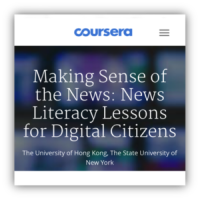
Never before has the need for News Literacy been more urgent. As news consumers are bombarded with a constant stream of fake news, propaganda, hoaxes, rumors, satire, and advertising — that often masquerade as credible journalism — it is becoming more and more difficult to distinguish fact from fiction. While the public’s faith in the news media erodes, purveyors of misinformation have helped give rise to troubling cultural trends and alarming political movements.
This six-week course will help learners develop their critical thinking skills to enable them to better identify reliable information in news reports and to become better informed about the world in which we live. The course will discuss the key elements of journalism from the viewpoint of the news audience.
The language of instruction is English, but Chinese and Spanish subtitles will be available. Each week will tackle a challenge unique to the digital era:
Week 1: The power of information is now in the hands of consumers.
Week 2: What makes journalism different from other types of information?
Week 3: Where can we find trustworthy information?
Week 4: How to tell what’s fair and what’s biased.
Week 5: How to apply news literacy concepts in real life.
Week 6: Meeting the challenges of digital citizenship.
(Copied from website)
